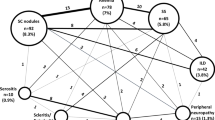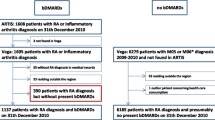Abstract
The aims of this study are to present the results of Egyptian RA patients included in COMORA cohort and compare it to general COMORA cohort, concerning prevalence of comorbidities, and level of application of recommendations related to detection/prevention of comorbidities. Three-hundred eight Egyptian RA patients included in the cross-sectional, observational, multi-center, international study “COMORA”, were compared to the total number of 3612 RA patients. The CRF of COMORA was used in all patients. CRF collects demographic and disease characteristics, comorbidities, risk factors, and compliance with recommendations regarding management of comorbidities. Data were analyzed according to COMORA protocol. Egyptian RA patients were significantly younger, had more active disease, and were more functionally disabled. They showed more frequent use of NSAIDs, methotrexate and steroids and significantly lower use of bDMARDs when compared to non-Egyptians. Egyptian patients had the highest ever HCV prevalence, while depression, hypertension, smoking and dyslipidemia were less prevalent in Egyptians. Prevalence of malignancy risk factors was highly deficient among Egyptians; primarily due to lack of screening. Further, following recommendations for monitoring comorbidities is significantly deficient among Egyptian patients. Egyptian patients had more active disease and more functional impairment than the rest of the COMORA cohort; with lower use of bDMARDs, that is possibly related to the economic situation. Also, there is a clear gap in screening and monitoring comorbidities. Awareness among Egyptian healthcare providers (and possibly similar third-world countries) to detect and manage RA-related comorbidities is required.


Similar content being viewed by others
References
Magnano MD, Genovese MC (2005) Management of co-morbidities and general medical conditions in patients with rheumatoid arthritis. Curr Rheumatol Rep 7(5):407–415
Al-Bishri J, Attar S, Bassuni N et al (2013) Comorbidity profile among patients with rheumatoid arthritis and the impact on prescriptions trend. Clin Med Insights Arthritis Musculoskelet Disord 6:11–18
Marks JL, Edwards CJ (2012) Protective effect of methotrexate in patients with rheumatoid arthritis and cardiovascular comorbidity. Ther Adv Musculoskelet Dis 4(3):149–157
Mikuls TR (2003) Co-morbidity in rheumatoid arthritis. Best Pract Res Clin Rheumatol 17(5):729–752
Linde L, Sørensen J, Østergaard M et al (2008) Health-related quality of life of patients with rheumatoid arthritis. Which factors are of significance? Ugeskr Laeger 170(10):855–858
Gullick NJ, Scott DL (2011) Co-morbidities in established rheumatoid arthritis. Best Pract Res Clin Rheumatol 25(4):469–483
Wotton CJ, Goldacre MJ (2012) Risk of invasive pneumococcal disease in people admitted to hospital with selected immune-mediated diseases: record linkage cohort analyses. J Epidemiol Community Health 66:1177–1181
Dougados M, Soubrier M, Antunez A et al (2014) Prevalence of comorbidities in rheumatoid arthritis and evaluation of their monitoring: results of an international, cross-sectional study (COMORA). Ann Rheum Dis 73(1):62–68
Fouad SA, Esmat S, Omran D et al (2012) Noninvasive assessment of hepatic fibrosis in Egyptian patients with chronic hepatitis C virus infection. World J Gastroenterol 18(23):2988–2994
El-Zorkany BK, Gamal SM, El-Mofty SA (2013) Frequency and causes of discontinuation of methotrexate in a cohort of Egyptian patients. Egypt Rheumatol 35(2):53–57
El Zorkany B, Alwahshi HA, Hammoudeh M et al (2013) Suboptimal management of rheumatoid arthritis in the Middle East and Africa: could the EULAR recommendations be the start of a solution? Clin Rheumatol 32(2):151–159
Smolen JS, Landewé R, Breedveld FC et al (2010) EULAR recommendations for the management of rheumatoid arthritis with synthetic and biological disease-modifying antirheumatic drugs. Ann Rheum Dis 69(6):964–975
Smolen JS, Landewé R, Breedveld FC et al (2014) EULAR recommendations for the management of rheumatoid arthritis with synthetic and biological disease-modifying antirheumatic drugs: 2013 update. Ann Rheum Dis 73(3):492–509
Devi DP, Sushma M, Guido S (2004) Drug-induced upper gastrointestinal disorders requiring hospitalization: a five-year study in a South Indian hospital. Pharmacoepidemiol Drug Saf 13(12):859–862
Strickland GT, Elhefni H, Salman T et al (2002) Role of hepatitis C infection in chronic liver disease in Egypt. Am J Trop Med Hyg 67(4):436–442
Strickland GT (2006) Liver disease in Egypt: hepatitis C superseded schistosomiasis as a result of iatrogenic and biological factors. Hepatology 43(5):915–922
Abdelwahab SF, Hashem M, Galal I et al (2013) Incidence of hepatitis C virus infection among Egyptian healthcare workers at high risk of infection. Clin Virol 57:24–28
El Garf A, El Zorkany B, Gheith R et al (2012) Prevalence and clinical presentations of hepatitis C virus among patients admitted to the rheumatology ward. Rheumatol Int 32:2691–2695
Cansu DU, Kalifoglu T, Korkmaz C (2008) Short-term course of chronic hepatitis B and C under treatment with etanercept associated with different disease modifying antirheumatic drugs without antiviral prophylaxis. J Rheumatol 35(3):421–424
El-Khalawany MA, Mahmoud AM (2014) The spectrum of cutaneous infection in diabetic patients with hepatitis C virus infection: a single-center study from Egypt. Indian J Dermatol 59(3):247–251
Grøn KL, Ornbjerg LM, Hetland ML et al (2014) The association of fatigue, comorbidity burden, disease activity, disability and gross domestic product in patients with rheumatoid arthritis. Results from 34 countries participating in the Quest-RA program. Clin Exp Rheumatol 32(6):869–877
Barber CE, Smith A, Esdaile JM et al (2014) Best practices for cardiovascular disease prevention in rheumatoid arthritis: a systematic review of guideline recommendations and quality indicators. Arthritis Care Res (Hoboken). doi:10.1002/acr.22419
Norton S, Koduri G, Nikiphorou E et al (2013) A study of baseline prevalence and cumulative incidence of comorbidity and extra-articular manifestations inRA and their impact on outcome. Rheumatology (Oxford) 52(1):99–110
Kim SY, Yoo CG, Lee CT et al (2011) Incidence and risk factors of steroid-induced diabetes in patients with respiratory disease. J Korean Med Sci 26(2):264–267
Machado RI, Braz Ade S, Freire EA (2014) Incidence of neoplasms in the most prevalent autoimmune rheumatic diseases: a systematic review. Rev Bras Reumatol 54(2):131–139
Symmons DP (2007) Lymphoma and rheumatoid arthritis—again. Rheumatology (Oxford) 46(1):1–2
Albrecht K (2014) Comorbidity in rheumatoid arthritis. Dtsch Med Wochenschr 139(37):1844–1848
Al Saleh J, Ragab G, Nash P et al (2015) Rheumatoid arthritis in the Middle East and Africa: are we any closer to optimising its management? Clin Rheumatol 34:1–8
Acknowledgments
The authors would like to thank the national principal investigators of the COMORA study: Gustavo Casado (Argentina), Josef Smolen (Austria), Bassel Kamal El-Zorkany (Egypt), Martin Soubrier (France), Gerd Burmester (Germany), Peter Balint (Hungary), Carlo Maurizio Montecucco (Italy), Masayoshi Harigai (Japan), Yeong-Wook Song (Korea), Najia Hajjaj-Hassouni (Morocco), Mart van de Laar (the Netherlands), Emilio Martin-Mola (Spain), Shue-Fen Luo (Taiwan), Jonathan Kay and Kevin Winthrop (USA), Gabriel Maciel (Uruguay), Anna Antunez (Venezuela); the scientific committee of COMORA study: Maxime Dougados, Peter Balint, Gerd Burmester, Paul Emery, Jonathan Kay, Emilio Martin-Mola, Iain McInnes, Carlo Maurizio Montecucco, Josef Smolen, and patients who agreed to participate in this study. Also, thanks to an unrestricted grant from Roche that supported study conduction.
Author information
Authors and Affiliations
Corresponding author
Ethics declarations
Funding
This study was conducted with the support of an unrestricted grant from Roche Ltd.
Disclosures
None.
Patient consent
Obtained.
Ethics approval
Obtained.
Rights and permissions
About this article
Cite this article
El-Zorkany, B., Mokbel, A., Gamal, S.M. et al. Comparison of comorbidities of the Egyptian rheumatoid arthritis patients to the global cohort of the COMORA study: a post-hoc analysis. Clin Rheumatol 35, 1153–1159 (2016). https://doi.org/10.1007/s10067-015-3142-4
Received:
Revised:
Accepted:
Published:
Issue Date:
DOI: https://doi.org/10.1007/s10067-015-3142-4




